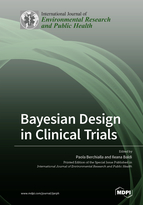Bayesian Design in Clinical Trials
A special issue of International Journal of Environmental Research and Public Health (ISSN 1660-4601).
Deadline for manuscript submissions: closed (30 September 2021) | Viewed by 33401
Special Issue Editors
Interests: bayesian statistics; machine learning; clinical epidemiology; precision medicine
Special Issues, Collections and Topics in MDPI journals
Special Issue Information
Dear Colleagues,
In the last decade, the number of clinical trials using Bayesian methods has grown dramatically. Nowadays, regulatory authorities appear to be more receptive to Bayesian methods than ever.
The Bayesian methodology is well-suited to address the issues arising in the planning, the analysis, and the conduct of clinical trials. Due of their flexibility, Bayesian design methods based on the accrued data of on-going trials have been recommended by both the US Food and Drug Administration (FDA) and the European Medicines Agency for dose–response trials in early clinical development. More generally, since the inherent adaptive nature of Phase I and Phase II designs, the Bayesian approach tends to be more efficient.
A recent development for oncology clinical trials is represented by the basket studies or multi-disease trials, which enroll patients that have a common genetic mutation but include different tumor types. A Bayesian approach through the Bayesian hierarchical model has the appeal of being able to improve the efficiency of such trials by properly borrowing information.
Another distinctive feature of the Bayesian approach is that it naturally allows for dealing with external information, such as historical data, findings from previous studies, and expert opinions through prior elicitation. In fact, it provides a framework for embedding and handling the variability of such auxiliary information within the planning and analysis of the study. A growing body of literature examines the use of historical data to augment newly collected data, especially in clinical trials where patients are difficult to recruit, which is the case for rare disease, for example. Many works describe the importance of using the available data in clinical trials and how this can be done properly. Using historical data has been recognized as less controversial than eliciting prior information from experts’ opinion also by the FDA in its guidance on the use of Bayesian Statistics in Medical Device Clinical Trials.
Papers addressing these topics are invited for submission to this Special Issue. Novel applications of Bayesian modeling to data from clinical trials, Bayesian designs for early phase trials, seamless phase II/III and phase III clinical trials, the Bayesian approach for monitoring, and hybrid Bayesian–frequentist designs are welcome, as well as papers addressing the advantages and limitations of the Bayesian approach carrying out virtual re-executions of published trials.
Dr. Paola Berchialla
Dr. Ileana Baldi
Guest Editors
Manuscript Submission Information
Manuscripts should be submitted online at www.mdpi.com by registering and logging in to this website. Once you are registered, click here to go to the submission form. Manuscripts can be submitted until the deadline. All submissions that pass pre-check are peer-reviewed. Accepted papers will be published continuously in the journal (as soon as accepted) and will be listed together on the special issue website. Research articles, review articles as well as short communications are invited. For planned papers, a title and short abstract (about 100 words) can be sent to the Editorial Office for announcement on this website.
Submitted manuscripts should not have been published previously, nor be under consideration for publication elsewhere (except conference proceedings papers). All manuscripts are thoroughly refereed through a single-blind peer-review process. A guide for authors and other relevant information for submission of manuscripts is available on the Instructions for Authors page. International Journal of Environmental Research and Public Health is an international peer-reviewed open access monthly journal published by MDPI.
Please visit the Instructions for Authors page before submitting a manuscript. The Article Processing Charge (APC) for publication in this open access journal is 2500 CHF (Swiss Francs). Submitted papers should be well formatted and use good English. Authors may use MDPI's English editing service prior to publication or during author revisions.
Keywords
- Bayesian design
- Interim analyses
- Bayesian hierarchical models
- Treatment response adaptive randomization
- Bayesian sequential design
- Bayesian monitoring
- Power priors
- Dynamic treatment regimes
- Historical controls







